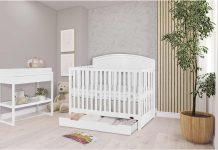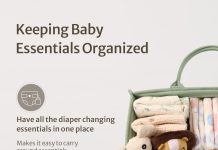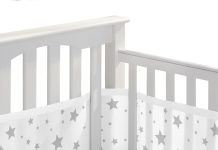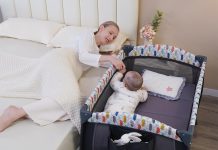Parents often find themselves wondering if it is safe to put their precious 3-month-old baby in a crib. After all, babies are delicate and need constant supervision, right? Well, fear not, because we have some reassuring news for you. In this article, we will delve into the topic and provide you with some expert advice on whether it is indeed okay to put a 3-month-old in a crib. So, sit back, relax, and let’s put your worries to rest.
Review contents
Safety Guidelines for Cribs
When it comes to choosing a crib for your little one, safety should always be the top priority. Cribs play a crucial role in creating a safe and comfortable sleeping environment for babies. Here are some essential safety guidelines to consider:
Cribs should meet safety standards
It is crucial to ensure that the crib you choose meets the necessary safety standards. Look for cribs that adhere to the guidelines set by regulatory bodies such as the Consumer Product Safety Commission (CPSC) or the American Society for Testing and Materials (ASTM). These standards ensure that the crib is built with safety in mind, including features such as sturdy construction, non-toxic finishes, and proper spacing between slats.
Cribs should have a firm mattress
A firm mattress is essential for your baby’s safety and comfort. It provides the necessary support for their growing bodies and reduces the risk of suffocation or Sudden Infant Death Syndrome (SIDS). Avoid using soft or plush mattresses as they can pose a suffocation hazard.
Cribs should have a snug-fitting sheet
Using a snug-fitting sheet is crucial for your baby’s safety. Loose or ill-fitting sheets can become a suffocation hazard if they come loose or get tangled around the baby. Ensure that the sheet fits tightly around the mattress, without any excess fabric that could be a potential hazard.
Cribs should have no loose or soft bedding
While it may be tempting to fill your baby’s crib with soft pillows, blankets, and stuffed toys for added comfort, it’s important to remember that these items can pose significant safety risks. Loose bedding increases the risk of suffocation and SIDS. Keep the crib free from any loose or soft items.
Cribs should be free from hazards
Inspect the crib regularly for any potential hazards. Check for loose nuts and bolts, sharp edges, or any other parts that might pose a danger to your baby. Ensure that there are no missing or broken parts that could compromise the crib’s structural integrity.
Cribs should be positioned away from windows
Place the crib away from windows to prevent the baby from accessing cords, blinds, or curtains. Additionally, avoid positioning the crib near any furniture that the baby can use to climb out of the crib. Creating a safe distance from potential hazards is essential to reduce the risk of accidents.
Cribs should have adjustable mattress height
Choose a crib with an adjustable mattress height feature. This allows you to lower the mattress as your baby grows and becomes more mobile. Starting with the highest setting will make it easier for you to reach and soothe your newborn, while lowering it as they grow will prevent them from climbing or falling out of the crib.
Cribs should have slats that are the correct distance apart
Ensure that the crib’s slats are spaced at the correct distance apart. The space between the slats should be narrow enough to prevent your baby’s head from getting stuck but wide enough to allow for proper airflow. This helps keep your little one safe and comfortable while they sleep.
Cribs should not have drop sides
Avoid using cribs with drop sides. While drop-side cribs were once popular, they have been banned in recent years due to safety concerns. The drop-side mechanism can malfunction, leading to entrapment or suffocation hazards for babies. It is safer to choose a crib with fixed sides.
Cribs should not have any missing or broken parts
Regularly inspect the crib for any missing or broken parts. If you notice any issues, promptly repair or replace the affected components. Broken or missing parts can compromise the crib’s structural integrity and pose a safety risk to your baby.
Advantages of Using a Crib
Using a crib offers several advantages for both babies and parents. Here are some benefits to consider:
Crib promotes a safe sleeping environment
Cribs are specifically designed to provide a safe sleeping space for babies. From the firm mattress to the snug-fitting sheet, cribs offer a secure environment that reduces the risk of suffocation or other hazards. By using a crib, you can have peace of mind knowing that your baby is sleeping in a safe place.
Crib helps establish a routine
Having a dedicated sleeping space, such as a crib, helps establish a bedtime routine for your baby. When they associate the crib with sleep, it becomes easier for them to fall asleep and stay asleep for longer periods. A consistent sleep routine promotes better sleep patterns, contributing to your baby’s overall well-being.
Crib provides a dedicated sleeping space for the baby
Using a crib allows your baby to have their own space for sleeping. This not only helps establish boundaries but also provides a sense of security and comfort. Having their own sleeping space promotes independence and fosters healthy sleep habits.
Crib allows parents to have their own sleep space
Using a crib also benefits parents by allowing them to have their own sleeping space. When the baby sleeps in a crib, the parents can enjoy uninterrupted sleep, which is essential for their own well-being. It also reduces the risk of accidental suffocation or rolling over the baby during sleep.
Crib can be used for longer durations compared to bassinets or co-sleepers
Cribs are designed to accommodate growing babies and can be used for a more extended period compared to bassinets or co-sleepers. As your baby grows, they will require more space and support. Investing in a crib ensures that your baby will have a suitable sleeping environment for an extended period, saving you the hassle and expense of transitioning to a new sleep setup too soon.
When Can I Put My Baby in a Crib?
Determining the right time to transition your baby to a crib can be a personal decision based on various factors. It’s always recommended to follow the guidelines provided by reputable sources such as the American Academy of Pediatrics (AAP) and consult with your pediatrician. Here are some considerations to keep in mind:
AAP guidelines for safe crib usage
The AAP recommends that babies should sleep in the same room as their parents for at least the first six months. Placing the crib in the parents’ bedroom helps ensure better monitoring and reduces the risk of SIDS. After the initial six months, parents can consider moving the crib to a separate room if they feel comfortable.
Consideration of the baby’s development
Each baby develops at their own pace. While some babies may be ready to transition to a crib by three months old, others may need more time in a bassinet or co-sleeper. Consider your baby’s developmental milestones, such as rolling over and sitting up, as these can indicate their readiness for a crib.
Factors to consider before transitioning to a crib
Before transitioning your baby to a crib, consider factors such as their sleep habits, comfort with separation, and overall safety. If your baby is used to the close proximity of a bassinet or co-sleeper, it may take some time for them to adjust to the crib. Assessing your baby’s readiness and comfort level is essential for a smooth transition.
Consultation with pediatrician
It’s always recommended to consult with your pediatrician before making any significant changes to your baby’s sleeping arrangements. They can offer personalized advice based on your baby’s unique needs and development. Your pediatrician can provide guidance on when it is safe and appropriate to introduce a crib for your baby.
AAP Guidelines for Safe Crib Usage
The American Academy of Pediatrics (AAP) provides essential guidelines to ensure the safe use of cribs. Following these guidelines can significantly reduce the risk of sleep-related accidents and promote a safe sleeping environment for your baby. Here are some key AAP recommendations:
Back-to-sleep position
Always place your baby on their back to sleep, both for naps and nighttime sleep. This sleeping position reduces the risk of Sudden Infant Death Syndrome (SIDS) and promotes safe breathing. Avoid placing your baby on their side or stomach to sleep.
Firm mattress with fitted sheet
Use a firm mattress inside the crib, and make sure it fits snugly. Loose or soft mattresses can pose suffocation hazards. Cover the mattress with a fitted sheet that fits securely. Avoid using additional bedding such as blankets, pillows, or stuffed animals in the crib.
No soft bedding or pillows
To reduce the risk of suffocation, remove all soft bedding from the crib. This includes crib bumpers, blankets, pillows, and stuffed animals. These items can increase the risk of suffocation or accidental entrapment.
Proximity to parents’ bed for the first six months
The AAP recommends keeping your baby’s crib in your bedroom for at least the first six months. This allows for easier monitoring and comforting during the night. Having the crib nearby reduces the risk of SIDS and provides convenience for nighttime feedings and soothing.
Considerations for Transitioning to a Crib
Transitioning your baby from a bassinet or co-sleeper to a crib can be an exciting milestone. However, it’s essential to consider certain factors before making the switch. Here are some considerations to keep in mind:
Baby’s ability to roll over
If your baby has started rolling over independently, it may be an indication that they are ready to transition to a crib. Rolling over signifies increased strength and mobility, which can make a crib a safer sleeping option.
Baby’s preference for more space
Observe your baby’s sleep patterns and their response to their current sleeping arrangement. If your baby seems cramped or uncomfortable in a bassinet or co-sleeper, it may be a sign that they are ready for the spaciousness of a crib.
Safety concerns in bassinets or co-sleepers
Bassinets and co-sleepers have weight and size limits that may no longer be suitable for your growing baby. Additionally, as your baby becomes more mobile, they may start reaching or grabbing objects that could pose a safety risk. Assess the safety concerns associated with your current sleep setup before transitioning to a crib.
Parent’s comfort with separation
Transitioning to a crib often involves moving the baby to a separate room, which can be emotionally challenging for some parents. Consider your own comfort level with separating from your baby during sleep before making the transition. It’s important for both you and your baby to feel secure and comfortable with the changes.
Preparing the Crib for a 3-Month-Old
When setting up the crib for your 3-month-old, ensure that the environment is safe, comfortable, and conducive to sleep. Here are some tips to prepare the crib for your little one:
Placement of the crib in the nursery
Choose a suitable location within the nursery for the crib. Ensure that the crib is away from windows and any potential hazards, such as cords or blinds. Placing the crib against a solid wall can provide additional security.
Choosing a suitable crib mattress
Selecting the right mattress is crucial for your baby’s comfort and safety. Opt for a firm mattress that fits securely within the crib. The mattress should be free from any gaps or spaces that could pose a safety risk. Keep in mind that a firmer mattress is recommended to reduce the risk of suffocation or SIDS.
Ensuring proper crib bedding
Use a snug-fitting sheet that covers the entire mattress. Avoid using loose or oversized sheets that can come loose and pose a suffocation hazard. Additionally, remove all other bedding, such as blankets, pillows, or crib bumpers, from the crib to minimize the risk of suffocation or entanglement.
Organizing the crib for comfort and safety
Ensure that the crib is free from any potential hazards, such as loose objects or protruding parts. Keep stuffed animals, toys, and blankets out of the crib to minimize the risk of suffocation or accidental entrapment. A clutter-free crib creates a safe and comfortable sleeping space for your baby.
Tips for Safe Crib Usage
In addition to following the specific safety guidelines, there are additional tips to keep in mind for safe crib usage. Here are some helpful tips:
Regularly check the crib for any hazards or damage
Inspect the crib regularly to ensure that it remains in good condition and free from any hazards. Check for loose parts, broken slats, or any other potential dangers. Promptly repair or replace any damaged components to maintain a safe sleeping environment for your baby.
Use a pacifier for sleep
Consider offering your baby a pacifier when placing them in the crib for sleep. The use of pacifiers has been associated with a reduced risk of SIDS. Avoid attaching the pacifier to a string or clip that could pose a strangulation hazard.
Maintain a consistent sleep routine
Establishing a consistent sleep routine can help your baby feel secure and comfortable in their crib. Stick to a regular bedtime routine, including a soothing bedtime routine such as a warm bath and reading a book. A consistent routine helps signal to your baby that it is time to sleep.
Monitor the baby using a baby monitor
Using a baby monitor can provide additional peace of mind while your baby sleeps in their crib. A monitor allows you to keep an eye and ear on your baby from another room, ensuring their safety and well-being. Choose a monitor with video and audio capabilities for optimal monitoring.
Be aware of Sudden Infant Death Syndrome (SIDS) risk factors
Educate yourself about the risk factors associated with SIDS to better protect your baby. These risk factors include smoking during pregnancy, exposure to secondhand smoke, and the use of soft bedding or loose items in the crib. Understanding these risk factors helps you make informed decisions regarding your baby’s sleep environment.
Alternatives to Cribs for a 3-Month-Old
While cribs are the most commonly used sleeping option for babies, there are alternative sleep solutions to consider. Depending on your specific needs and preferences, you may find these alternatives suitable for your 3-month-old:
Bassinets
Bassinets are smaller than cribs and provide a cozy sleeping space for newborns and young babies. They are portable and can be placed next to the parents’ bed for easy access during nighttime feedings. However, keep in mind that bassinets have weight and size limitations and may need to be transitioned to a crib as your baby grows.
Co-sleepers
Co-sleepers attach securely to the side of the parents’ bed, providing a safe shared sleep space for the baby. Co-sleepers allow for easy access to the baby during nighttime feedings or comforting. It’s important to choose a co-sleeper that meets the necessary safety guidelines and provides a secure sleeping environment.
Playards
Playards, also known as playpens or pack ‘n plays, offer a versatile sleep solution for babies. These portable sleep spaces can be used as cribs when traveling or when you prefer to have your baby close by during the day. Playards often come with additional features such as a changing station and storage, making them a convenient and multifunctional option.
Bed-sharing
Bed-sharing involves having your baby sleep in the same bed as the parent(s). This approach requires specific safety considerations, including a firm mattress, no loose or soft bedding, and a safe sleep environment. Bed-sharing is a personal choice but should be done cautiously and with expert guidance to mitigate the risks associated with this sleeping arrangement.
Precautions for Bed-Sharing
If you choose to bed-share with your baby, it’s crucial to follow safety guidelines to reduce the risk of accidents or suffocation. Here are some precautions to consider:
Safety guidelines for bed-sharing
Ensure that the bed is large enough to accommodate both you and your baby comfortably. Use a firm mattress with a snug-fitting sheet. Remove pillows, blankets, and soft bedding from the bed. Keep your baby away from the edge of the bed and ensure that there are no gaps or crevices where your baby could become trapped.
Potential risk factors of bed-sharing
Bed-sharing has been associated with an increased risk of SIDS and suffocation if not done correctly. Risk factors include parental smoking, drug or alcohol use, or excessive bedding in the bed. It’s crucial to assess the safety of your sleep environment and make informed decisions based on the well-being of your baby.
Consultation with healthcare provider
It’s recommended to consult with your healthcare provider if you are considering bed-sharing. They can provide personalized advice and guidance based on your specific circumstances. Your healthcare provider can help you understand the potential risks and benefits associated with bed-sharing and offer recommendations that prioritize your baby’s safety.
Conclusion
Choosing the right sleeping arrangement for your 3-month-old is an important decision that should prioritize their safety and comfort. Cribs offer a secure and dedicated sleeping space that promotes safe sleep practices. By following safety guidelines, establishing a consistent sleep routine, and considering the developmental needs of your baby, you can create a safe and comfortable sleep environment. Remember to consult with your pediatrician and stay informed about the latest guidelines on safe sleep practices. With careful consideration and attention to safety, you can ensure that your 3-month-old sleeps soundly and safely in their crib.






























